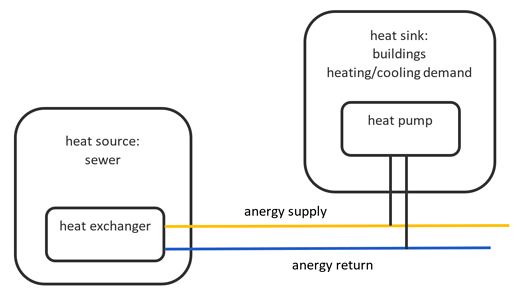Hello, I am new to working with oemof and tespy and thus I am not sure how well the following use case can be investigated in oemof-solph and/or tespy.
The energy system under observation consists of several heat pumps, an anergy network (LowEx) and a heat exchanger. The heat exchanger transfers heat from a sewer to the anergy network, which in turn serves as a heat source for the heat pumps that provide heating or cooling to large buildings.
I would like to analyze how the temperatures in the anergy network respond to fluctuating tempera-tures in the sewer on the one hand and to varying heat consumptions of the heat pumps on the other. Ultimately COP and annual COP of the heat pumps should be calculated, based on these informations.
Thank you for any advice.
To note that anergy is an energy flow lacking available work or exergy. Therefore at the dead‑state, including without kinetic or potential energy. It is a reasonable term to use in this context, but others might not be familiar with the construct. HTH, R
Not suggesting you use this long abandoned deeco framework but it dealt with the same question using “thermal sub‑networks” or TSN. As described here in §8.6 (p146–150) (starting 161 on the PDF):
If you look at this in steady state conditions, that could be a very good example use for TESPy. You model heat pumps and heat exchanger and can then calculate missing quantities. Note that this will not be an optimisation (you mentioned solph) but a simulation where you have to give enough parameters to fully determine the problem.
Hi @yann,
Hi @yann,
you can do these things with tespy. For that, you have to set up your system with the tespy components to the level of detail necessary for your investigation, i.e. components of the heat pump and the refrigerant(s), the piping network, the heat exchanger etc… tespy will allow you to calculate your results, e.g. based on information provided to the components like compressor efficiency, pipe insulation and so on.
I recommend, you build your model step by step and start with a simple model which you can add more and more components once you are familiar with tespy.
For this, you would need to run multiple tespy simulations, where you update your boundary conditions (ambient temperature, heat demand, heat supply by sewer, …) of the tespy model for every timestep. As @pschoen already mentioned, tespy only does the thermodynamic steady state simulation, it does not optimize the dispatch of the plants. Therefore these boundary condition information have to come from a different source. That could be, for example, an oemof-solph model, which calculates the optimal plant dispatch to supply all the heating demand.
Best
The method I noted in the third post mimicked the control system in place and not the physics and related loss mechanisms present. And then folded that information into an intertemporal optimization problem. For completeness, the broader theoretical model behind deeco was published as:
The manuscript originally contained the aforementioned TSN algorithm, but that material was later deleted in an effort to shorten the paper to meet reviewer expectations (as relayed to me by one of the co‑authors).
I also think that oemof might be the closest contemporary “successor” to deeco? HTH, R
